How Long Cooked Turkey In Fridge
How to melt a turkey? Don't waste your time with other posts. Here'southward the plain truth: The hush-hush to perfect turkey is proper control of turkey temperature . And that's our jam. Use any recipe you like—deep-fry information technology, smoke it, roast information technology, whatsoever. But neglect these cardinal principles at your ain peril!
Turkey Doneness Temperature
Turkey Doneness Temp: 157°F (69°C) in the chest— not 165°F !, and 175°F (79°C) in the thigh for moist turkey. (USDA charts hither or read more below to see why this is safe.)
How to Cook a Turkey at a Glance: Cooking Time and More
- Thawing: Y'all need to verify that your turkey is fully thawed before putting it in the oven or smoker or frier to avoid disaster. All-time thaw method is in the fridge—ane day per 5 lbs.
- Internal Temp Tracking: Rail internal turkey temps while roasting, if y'all can. Place an alarm thermometer probe in the thickest office of the breast (another in the thigh).
- Oven Temps: All-time roasting is 2 stage process—450°F (232°C) for 1 hour, and so downward to 325°F (163°C) for however long it takes until the turkey is done. If you read a post telling you exactly "how long to melt a turkey," hit the back button fast.
- Verify Turkey Doneness: Be sure to verify your doneness temps with an instant-read thermometer. The lowest reading y'all find should be 157°F (69°C) in the breast or put it back in the oven or smoker a little longer.
How to Melt a Turkey In Depth: Everything You Need to Know…
No other holiday has such a laser focus on a single piece of nutrient—the Thanksgiving Turkey. If the turkey isn't right, the 24-hour interval gets an asterisk. If the turkey is simply perfect, everyone somehow feels more thankful. To say nothing nigh the real danger of food poisoning with poultry! And YET, how often do yous melt a whole turkey during the other 364 days of the twelvemonth? Maybe at Christmas? Maybe never? Cooking a perfect Thanksgiving Turkeyon cue is a little like existence called in to throw the winning touchdown when you haven't touched a football all twelvemonth. Merely don't worry. We've got y'all covered.
At present that you've reviewed the "at a glance" headlines, it'southward time to dig a little deeper. Permit's outset with some of the most common questions…
HOW LONG TO COOK A TURKEY?
Maybe the question people ask almost almost cooking a turkey is "how long it is going to accept?" Charts and posts well-nigh turkey cooking times grow promising "Turkey Cook Times," merely they all share the same primal flaw—no chart can accept into account all the variables that can actually affect your particular turkey'southward actual cooking time…
Things that Change Rate of Cooking…
- The accuracy of your oven or smoker (most ovens are off their set indicate by 25-50°F [14-28°C])
- The type of oven (conventional, convection)
- Uneven heating flow in your oven
- Where the turkey is positioned in the oven or smoker
- The depth and size of the pan
- The blazon of roasting pan: whether information technology's dark, shiny, or deadening
- Using a roasting pan with a lid (don't practice this BTW)
- The exact size of your turkey
- Information technology'southward shape dimensions relative to other turkeys
- The fat content of your turkey
- How warm it was when it went into the oven or smoker
- Whether it was completely thawed or still partially frozen
- Whether it was tented with foil or non
- Whether information technology is stuffed or unstuffed
So, can you trust a turkey time nautical chart to make sure your turkey is a) done enough to be condom to eat or b) not dry and tasteless? No, you cannot. Time charts do have their use. They assistance you estimate when to beginning cooking your turkey relative to dinner fourth dimension. Simply for succulent turkey, you want to cook your turkey until it is done and not a moment longer.
WHAT TEMPERATURE IS TURKEY DONE?
Click on almost any other "how to melt a turkey" mail and you lot'll run across the same bad information repeated over and over. Just despite what they all say, you admittedly should Not cook your turkey breast meat to 165°F (74°C) or to—sky forbid—180°F (82°C)!
Our reply? Cook the breast meat to 157°F (69°C) for moist, juicy turkey.
Bone dry turkey white meat is the reason so many people kind of hate turkey. Information technology's also why turkey gravy and cranberry sauce are de rigueur on so many Thanksgiving dinner tables. But if y'all've e'er eaten properly cooked turkey white meat, you know it can exist moist and admittedly delicious without any added condiment!
TWO DIFFERENT TYPES OF MEAT
Office of the claiming hither is that a whole turkey really has ii very different types of meat on the aforementioned bird: the lean and tender white meat of the breast and the heavily worked dark meat of the legs and thighs. Cooking them at the same time is a little like trying to cook a steak and a brisket in the same oven. Since the dark meat, like a brisket, needs higher temperatures for the collagen to cook, our recommendation for the tender dark meat is 175-180°F (79-82°C)! (Read more than hither about how to achieve both temps in the aforementioned bird.)
IS Information technology Safety TO Consume?
The other challenge is that people misinterpret the nutrient safety tables put out by the USDA. Achieving a reduction of the poultry pathogen Salmonella is a function of both time and temperature. Annotation this screenshot from the USDA'south own tables on turkey safe…
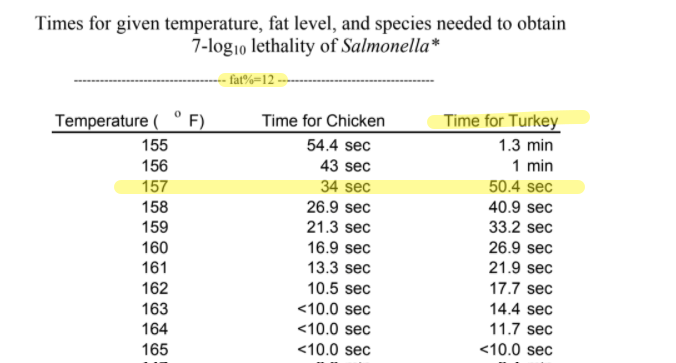
This shows that a turkey held at 157°F (69°C) for 50.4 seconds will achieve the same lethality on Salmonella as a turkey cooked to 165°F (74°C) does instantaneously. And what are the odds that a turkey pulled at 157°F (69°C) will remain at that temp for at least a minute? 100% considering of something called Carryover Cooking. The temperature is actually guaranteed to keep going up for a spell later you remove it from the oven or smoker.
Meanwhile the white meat in turkey volition start to expel its water in the 150's F (lx'south C) and exist bone dry by the time it reaches 165°F (74°C).
Do your family unit a favor this Thanksgiving. Pull your turkey from the oven or smoker at 157°F (69°C). Simply retrieve to verify!
With those large questions out of the way, let's get downward to brass tacks. Hither'due south the all-time advice you'll find on how to cook an amazing turkey. It starts correct up front end with the thaw…
Role 1: HOW TO THAW A TURKEY
It's frequently overlooked merely the first key to delicious turkey is proper thawing. Y'all can really cook a fully frozen turkey and, of grade, you can cook a fully thawed turkey. But cooking a turkey that ispartially thawed and partially frozen on Thanksgiving morning is a recipe for disaster.
A partially frozen turkey will cook unevenly. By the time the inner frozen surface area thaws and comes to its pull temperature, the outermost layers of the turkey will be woefully overcooked.
THE BEST METHOD: HOW TO DEFROST A TURKEY IN THE Fridge
The best manner to become an evenly thawed turkey is the slow and gentle way. Information technology takes a little forethought and making some room in your fridge but is the easiest method, also.
Steps
ane.
Put your frozen turkeybreast-side Upward on a rimmed sheet pan or tray in your fridge ready to37°F (3°C).
2.
Allow at to the lowest degree24 hours for every 5-6 pounds (2.3–2.7 kg) of frozen turkey. A 20-pound (9.i kg) turkey volition take 4 total days to thaw in a refrigerator.
TURKEY THAW Mean solar day
For almost all turkey sizes, the Saturday before Thanksgiving is the perfect day to place your frozen turkey in the fridge—allowing plenty of time for thawing without letting the thawed turkey overstay information technology'south welcome in the fridge before cooking. Then marking "Turkey Thaw Twenty-four hours" on your calendar at present!
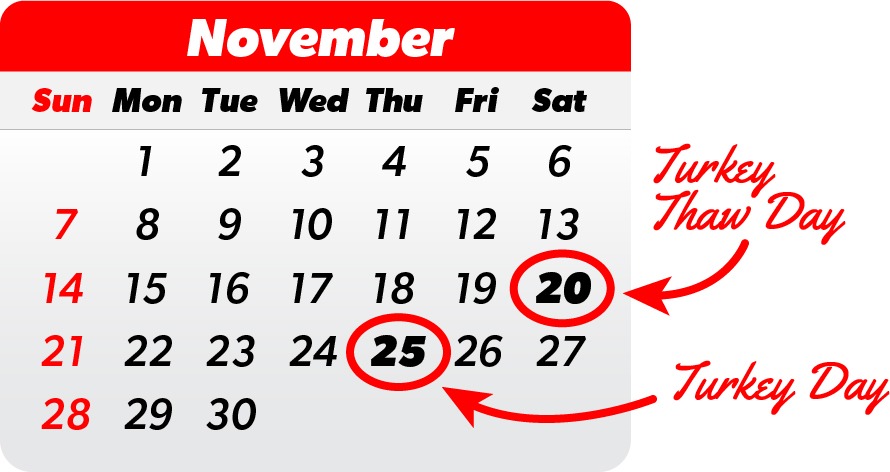
SPEED THAW METHOD
If you don't accept several days at your disposal, you can try thespeed method.
H2o has a much greater molecular density than air. Heat transfer from the molecularly dumbo h2o to the frozen turkey happens much faster than in air. Yous will demand to allow at least 30 minutes per pound(per .45 kg), so it will still take some time.
Steps
1.
Place your unopened turkey (it must be in airtight wrapping)breast-side Downwards in a cooler and fill with cold h2o to embrace. Your turkey may bladder at starting time, that'due south okay. It will begin to sink as it thaws.
two.
Utilize an warning thermometer like the ChefAlarm ® with its high alarm prepare to41°F (four.five°C) to track the water temperature during a water thaw. (If you lot similar, yous can also take advantage of the ChefAlarm'southward built-in timer to go along rail of your hours.) Or spot-cheque the water'southward temperature every half hour with an instant-read thermometer similar a Thermapen, and add ice to keep the water attwoscore°F (4.4°C) or below. This is very of import! If the h2o gets above twoscore°F (4.4°C) while the turkey is thawing, leaner may begin to grow that could survive the cook.
This procedure may require 1-2 big numberless of water ice—then be prepared.
VERIFYING THAT YOUR TURKEY IS THAWED
Whichever method y'all use, you lot should E'er verify that the internal temperature of your turkey is above freezing Earlier putting it in the oven or smoker. Again, you lot can actually melt a frozen turkey and, of class, y'all can cook a thawed turkey, but yous can't cook a partially thawed, partially frozen turkey. If the middle of the turkey is even so frozen, by the time it comes to a food condom temperature, the outside meat will exist burned to a crisp.
Steps
1.
Using a fast and authentic instant-read thermometer, like Thermapen I, push the probe tip through the wrapper, deep into the breast and pull it out noting the temperature reading as it changes. The everyman temperature you come across should be thirty°F (-one°C) or in a higher place (and, of course, below the danger zone— 40°F [iv.4°C]). Check in several places. Check deep in the thigh and next to the neck cavity likewise.
2.
If you encounter ice with the probe, or see a temperature reading beneath 30°F (-1°C), continue thawing using either method above until the turkey is fully thawed.
PART ii: PREP YOUR TURKEY Skin FOR THE OVEN OR SMOKER
One of the most succulent parts of a properly cooked turkey is crispy pare. And crispy pare after cooking starts with DRY skin before cooking. Water on the surface of the meat will slow down the cook, and cause uneven browning. The heat of the oven or smoker must first piece of work to evaporate the surface moisture before the cooking really begins.
Then, prep your turkey skin by either drying or, better yet, dry out brining your turkey skin before cooking.
Steps
1.
Pat your turkey dry with paper towels right earlier cooking. (This is particularly of import if you wet-brined your turkey in saltwater). Be certain to become the entire surface of the turkey (even the inside surface of the main cavity and neck cavity)dainty and dry before seasoning.
2.
Slather on the butter or oil and spices (whatever your recipe calls for) and start cooking.
iii.
Optionally, get fifty-fifty crispier peel and juicier, more flavorful turkey meat by dry out-brining your bird. Dry out brining is essentially air-drying your turkey. Later applying your spices (nosotros prefer just plain common salt and pepper), leave youruncovered in the fridge on a baking tray for the morning (eight hours) before or the entire twenty-four hour period before (24 hours) cooking your turkey.
Part 3: TRACKING YOUR TURKEY'S INTERNAL TEMPERATURE
TWO THERMOMETERS ARE Ameliorate THAN Ane
The more uniform a piece of meat is in shape and size, the more evenly it will cook. (This is why we tie upwardly roasts and butterfly some cuts of meat before cooking them.) Needless to say, whole turkeys are anything but uniform in shape! The breasts are thick at ane end and tapered toward the other, while the legs are quite a bit smaller. These different areas of the turkey simply will not melt at the aforementioned rate.
That's why it's of import both to rails your cooking temp with a cooking alarm thermometer like Smoke X, ChefAlarm, or DOT (sometimes called a "leave-in probe thermometer" or an "oven thermometer") and to verify your doneness temps with a fast and accurate instant-read thermometer. Two dissimilar thermometers for two different just very important jobs.
If you only have one, the instant-read is the more of import, since information technology allows you to verify doneness temperature in multiple places. But each time you open up the oven door or the smoker lid to check on your turkey temps, you're likely to reduce the internal temperature of the oven or smoker by equally much equally 50°F (28°C). Each time!
But with an warning thermometer, you'll be able to rails your turkey's internal cooking temperature from outside the oven or smoker, and then you won't miss the critical moment when your turkey is done!
Recall, your goal is to cook your turkey breast to exactly 157°F (69°C) and not 1 degree more before removing it from the oven, smoker, or frier.
Role 4: WHERE TO Identify THE THERMOMETER PROBE
Most "How to Cook Turkey" posts show the thermometer sticking straight up out of the breast of the turkey, but that is a bad idea. The "gradients" or dissimilar temperatures in a turkey chest while it cooks follow the contours of the breast itself, which are long and flat (movie a chicken breast).
Pushing a probe vertically through the acme means you are cut across those gradients. That's the right way to verify the doneness of the bird, but for temperature tracking, we recommend increasing the likelihood that you position the probe sensor in the "thermal center" of the breast past post-obit its contours and inserting the probe horizontally, parallel to the baking tray.
Steps
ane.
Hold the probe against the turkey breast to estimate how deeply you should push the probe tip into the chest to reach its heart. With your other mitt, pinch almost where yous call up the probe will accomplish the outer edge of the turkey.
two.
Insert the probe laterally, from near the neck cavity, parallel to the cutting board or pan up to your fingers pinching the probe with your other paw.
3.
The probe'due south tip should be about 1/2 to one inch (ane.3 to two.5 cm) from the internal cavity of the bird to avoid touching the bone. You can wiggle the probe tip within the turkey breast and feel with your other mitt to verify it is near the center of the breast.
4.
If you Practice accept a 2nd probe to work with, push button it deep into the thigh—between the leg and the body of the turkey. If you hit bone, pull the probe tip back half an inch.
five.
Set the alert thermometers high alert to 157°F (69°C) in the breast. If you take a second channel for a 2nd probe in the thigh meat, set its high alarm to 175°F (79°C).
With a cooking warning thermometer yous will be able to track your turkey's internal temperature from your counter top! Avoid the temptation to open the oven or smoker, and let out the hot air, until the alarm sounds.
When the alarm sounds, it's time to verify the doneness of your turkey.
Function 5: VERIFYING PULL TEMPS—HOW TO KNOW WHEN YOUR TURKEY IS Really Washed
The best fashion to know your turkey is done is, but, to accept its temperature. Yes, y'all've been monitoring the temp with a leave-in probe thermometer, but there's a expert chance that you didn't hit the thermal center with the tip of the probe, despite your all-time efforts. Verifying your turkey's temperature with an instant-read thermometer like the Thermapen ® Ane is crucial in making certain your bird is fully cooked.
HOW TO VERIFY YOUR TURKEY'S TEMPERATURE
When your warning thermometer's high warning sounds at157°F (69°C) in the chest, it's fourth dimension to verify that its reading is the lowest temperature.
Remember, your turkey is only as done every bit thelowest internal temperature you can discover.
Steps
1.
Using a fast and authentic instant-read thermometer, like a Thermapen ONE, plunge the probe deep into the breast meat from the tiptop and then pull the probe tip up slowly back through the turkey meat watching the thermometer display.
2.
Do this in at least two places in the breast. You're looking for a lowest-temperature reading of at least157°F (69°C) in the breast meat.
3.
If you lot see temperatures below157°F (69°C) in the breast, reposition of thewarning thermometer's probe until the reading on the alert thermometer matches the lowest reading y'all found on the instant-read (be careful to apply a hot pad on the hot probe). Return the turkey to the oven or smoker to proceed cooking until the alarm sounds again and 157°F (69°C) is the lowest temperature institute in the breast.
4.
When the breast meat doneness temp is verified, go ahead and check your dark meat by pushing the probe tip of your instant-read thermometer deep into the thigh meat between the leg and the torso of the turkey. Pull the probe tip up slowly back through the thigh meat watching the thermometer display.
v.
The dark meat will will taste better at temperatures above175°F (79°C) but is perfectly safe to eat above165°F (74°C). (Read more about how to reach college temps in the dark meat while keep the chest meat tender.)
PART 6: Residuum YOUR TURKEY AFTER COOKING
Pulling your turkey from the oven or smoker or frier is really Not the concluding stride earlier etching and serving. Resting your turkey is. We recommend a 30-minute rest before carving.
Why rest? Two important reasons…
1. CARRYOVER COOKING IN TURKEY
The higher temperatures that be on the outside of the turkey volition proceed moving toward the lower temperature middle area of the meat fifty-fifty after you take your turkey out of the heat.
This is called carryover cooking. While small-scale cuts of meat like steaks or chops feel minimal carryover, large cuts, like turkeys or roasts, can experience as much as 5-10°F (three-half dozen°C) increase in internal temperature while the exterior cools. We telephone call the way a cooked turkey comes to ane temperature while information technology rests "equilibration."
2. REDISTRIBUTION OF EXPELLED JUICES
Another reason to rest your turkey is so it has a take a chance to reabsorb its juices.
While exposed to the intense heat of an oven, smoker or fryer, turkey meat'southward protein fibers shorten, shrink and contract, expelling out the water they've retained. During the rest, these protein fibers have a adventure to relax and reabsorb some of the juices that are lost. A turkey carved and served without resting volition spill more of its juices onto the cutting board and non be every bit moist.
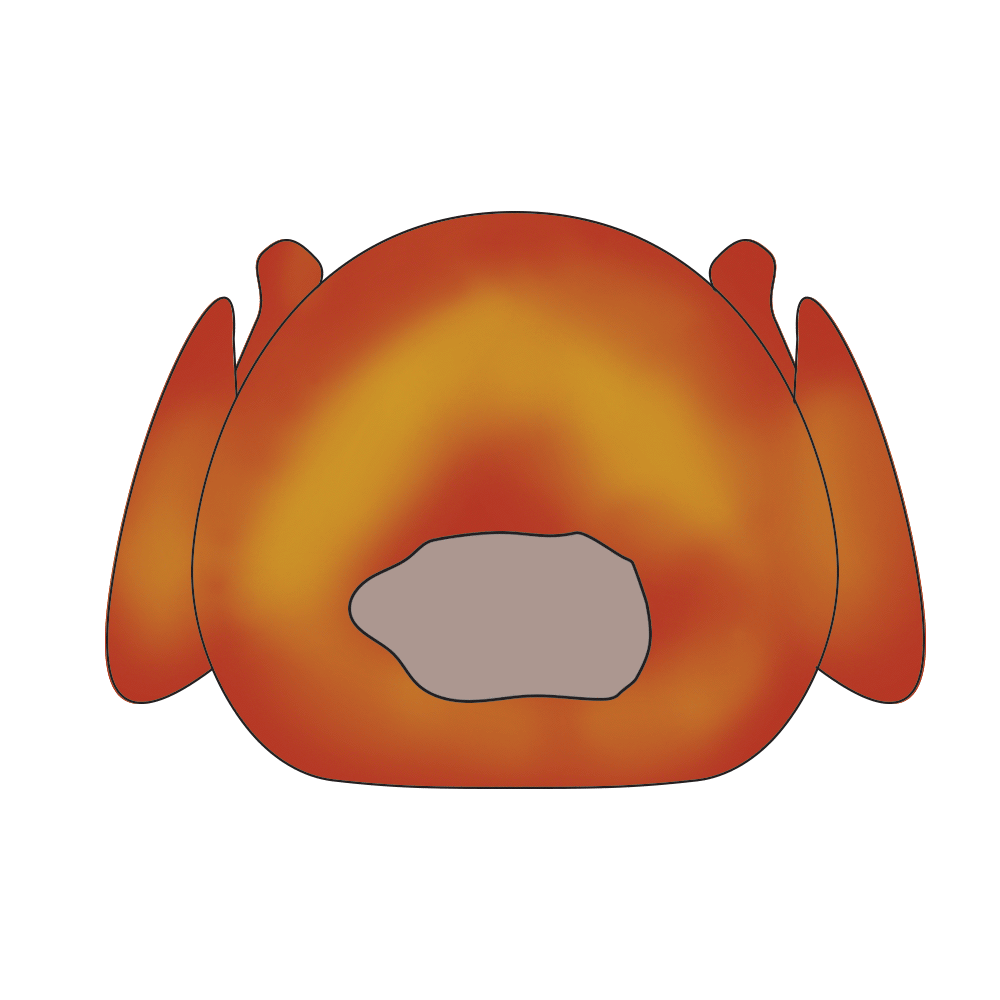
HOW TO Track CARRYOVER COOKING DURING THE REST
Steps
1.
Once you have verified that your turkey has reached its pull temperature of157°F(69°C), remove the turkey from the oven or smoker.
2.
If you have a ChefAlarm or Smoke alarm thermometer from ThermoWorks, leave the probe in place, and the alarm thermometer will record the maximum temperature reached by the internal meat of the turkey during the residue.
3.
Gear up a timer for 30 minutes, and permit your turkey to rest at room temperature (the ChefAlarm has i built-in).
4.
Bank check the ChefAlarm or Smoke's Max temperature reading to come across what your turkey's last resting temperature was. Even if your turkey didn't accomplish165°F (74°C), it only needs to be held for 25.six seconds at160°F (71°C) to reach the aforementioned level of food safety (a 7-log reduction in pathogens as defined by the USDA).
v.
If you lot want your turkey skin to stay crispy, continue the turkeyuncovered during the rest. If you need to agree the turkey for longer than one-half an hour before serving, keep it warm in an oven set to150°F (66°C). Leave your alarm thermometer probe in place and rail the internal temperature while yous wait.
APPENDIX 1: TO GET It RIGHT, UNDERSTAND THESE three THINGS
one. TEMPERATURE GRADIENTS
While meat is cooking, rut transfers from the outside in. Considering of this, the outside of a turkey will be at a college temperature with lower temperatures every bit you motility toward the center of the meat. This divergence in temperature between the exterior and interior of the meat is referred to as a temperature gradient .
When cooking anything,the higher the temperature yous cook at, the larger the temperature gradient inside the meat. That is, turkey cooked at 450°F [232°C] will have a larger ring of overcooked meat around its edges than turkey cooked at 250°F [212°C].
—The Food Lab'due south Step-by-Step Guide to Smoking A Turkey, J. Kenji Lopez-Alt
Understanding temperature gradients leads correct into the core of where to place your thermometer'south probe. The thermal center:
2. THERMAL Centre
The thermal center is the point in the turkey furthest from the exterior of the meat that takes the longest to melt.
The largest mass of the turkey is its breast meat, and the deepest function of the breast in its thickest expanse is where the thermal center will be. This lowest temperature is the one that needs to be tracked during the cook consideringyour meat is only equally washed and safe as the lowest temperature establish.
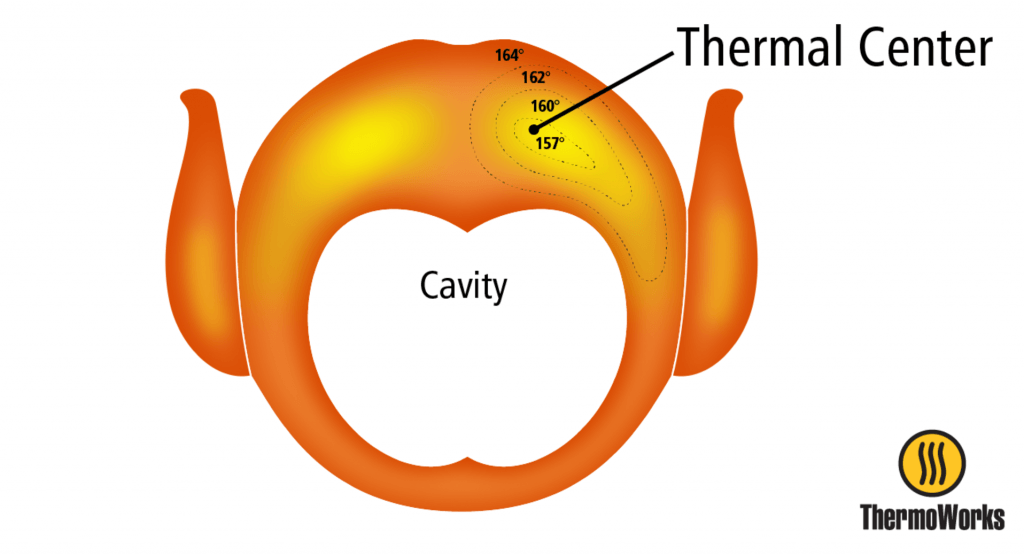
3. Empathize YOUR THERMOMETER'S PROBE
For thealmost accurate probe placement, it helps to know a thing or two nearly your leave-in thermometer'southward probe. You lot need the function of the thermometer that isactually taking the temperature to be in the thermal center. It's worth noting that this is physically incommunicable with an old-fashioned dial thermometer. The sensor in dial thermometers is an inch-long spring that averages temperatures over the bottom inch of the probe to accept a reading. And the and then-called "pop-upwardly thermometers" that come in some turkeys are only measuring the outer quarter inch of the chest!
Just for a digital thermometer probe, similar our industry-leading Pro-Series probes, the sensor that needs to be in the thermal center is the tiny cone at the very tip of the probe.
With the sensor in such a pocket-sized area, you can pinpoint authentic readings from within very small temperature gradients in the meat. Just make sure your probe tip is in the thermal center!
APPENDIX 2: HOW TO GET HOTTER DARK MEAT THAN WHITE MEAT
To accomplish the finish goal of tender, juicy breast meat and silky, succulent nighttime meat, the internal temperature in the thighs needs to exist at least 175°F (79°C) by the fourth dimension the chest meat reaches 157°F (69°C).
To assistance alleviate the challenge of cooking two completely different types of meat at the same time, chefs and food science experts have pushed different methods, including roasting the turkey upside down, shielding the breasts with tin can foil, or even separating the white meat from the dark meat and cooking them separately.
But if yous want to keep the turkey whole, there are two methods that we have plant stand to a higher place the rest when it comes to the thermal principles at play that make or break turkey success.
Option 1: ICING THE BREASTS
This method, recommended past Harold McGee, gives the nighttime meat a thermal head commencement before the turkey goes into the oven or smoker and information technology works similar a charm. It may seem a fleck alarming to leave the turkey out on the counter for a couple of hours before putting it in the oven or smoker, only food safety experts who know about the Temperature Danger Zone, know that nutrient can safely rest between twoscore and lxx°F (4 and 21°C) for a total of 4 hours.
Steps
1.
Fill two sandwich or quart-sized Ziploc numberless (depending upon the size of the turkey) with ice and clip them together at the top with a binder clip.
2.
Remove the turkey from the fridge and set up it on a baking tray on the counter. Balance the Ziploc bags over the breasts
3.
Set a timer, like the Actress Big & Loud, for 2 hours. When the timer goes off, remove the ice bags, properly place your probes and immediately put the turkey in the oven or smoker as usual.
iv.
Optionally, one hour into your breast icing, place a ceramic pizza stone in the oven and preheat the oven to 500°F (260°C) for one 60 minutes to allow the pizza stone to absorb rut. The hot pizza rock nigh the bottom of the turkey—where the legs and wings are—will aid maintain a temperature differential between the dark meat and calorie-free meat. When the final 2-hr timer sounds, reduce the oven to 450°F (232°C) earlier putting the turkey in the oven.
5.
If you are able to track both the breast meat and the thigh meat temperatures while you are cooking, you should notice a good x to xv°F differential (6 to 8°C) between the two that will track the whole way through the cook.
OPTION two: SPATCHCOCKING
Of all the turkey cooking methods, this one delivers the biggest punch, in our humble stance. If you've e'er baked a pan of brownies you must accept noticed how the brownies near the edge of the pan are fully cooked while the brownies in the center of the pan are still gooey.
Spatchcocking involves removing the backbone of the turkey to allow it to be flattened into a roasting tray and relies on the same principle to "fully cook" the dark meat on the outside of the tray while keeping the white meat in the libation center.
Learn more near spatchcocking turkey here.
APPENDIX 3: CARVING
Carving your turkey properly is the perfect finishing bear upon. Not but does information technology make information technology easier for people to eat, but it is the perfect way to publicly demonstrate your new-found turkey prowess! But carving a turkey—with all its nooks and crannies, the legs, wings, and breasts on the ribcage—is not similar carving a tenderloin. It takes a strategic program.
To carve your turkey…
Steps
1.
Remove the turkey leg by slicing downwardly between the thigh and breast. Pull the thigh away from the chest until the thigh pulls out of joint. Finish severing the joint with the point of your knife until the entire leg is free.
two.
Split up the turkey drumstick from the thigh by following the line between the leg and the thigh with the point of your knife. Again, pull the drumstick abroad from the thigh to reveal the joint. Terminate severing the joint with the point of your knife.
Practise the same to the other thigh and drumstick.
three.
Free the breast by cutting down correct adjacent to the keel bone. Angle your knife outward and follow the bone construction down of the bird all the way along the ribcage until the breast meat is free. Starting at one tip, piece the breast meat into cross-sections, each with their own strip of pare.
Repeat on the other breast.
4.
Remove the wing by pulling the wing abroad from the carcass to identify the joint. Sever the joing with the point of your pocketknife. Echo for the other wing.
Conclusion
We hope that your Thanksgiving or holiday turkey is the best you've always had! No matter your recipe, be sure to follow all these thermal guidelines to get the very best results this twelvemonth and again next year, too. Good luck and happy cooking! And exist sure to allow us know how YOUR turkey turned out below in the comments section…
Description
How to cook a turkey, the easy, accurate manner
- i turkey, thawed until no part of the bird is colder than 30°F (-one°C)
- Kosher salt
- Blackness pepper
- Oil or rendered fat
The day before you lot melt the turkey—dry out brine: optional but highly recommended.
- Unwrap the turkey and remove the cervix and giblets, if present.
- Identify the turkey on a rack set in a rimmed baking tray.
- Liberally coat the skin of the turkey with kosher table salt and season information technology with pepper.
- Place the turkey, unwrapped, in the refrigerator on the lesser shelf. Let information technology sit down overnight.
The day of the cook
- Preheat oven to 425°F (218°C)
- Dry out the skin with newspaper towels if information technology is damp, or if you didn't dry out alkali information technology.
- Rub the skin well with oil or rendered fat.
- Place a scattering of aromatics in the cavity of the turkey.
- If yous didn't dry brine, season the peel well with salt and pepper.
- Probe the turkey in the deepest part of the breast with the probe from a ChefAlarm. Set the loftier-temp alarm for 158°F (69°C).
- Identify the turkey in the oven and cook for 1 hour.
- Plow your oven'southward temperature down to 325°F (163°C), open the door briefly to vent estrus.
- Proceed to cook the turkey until the high-temp alarm sounds.
- Verify the temperature with your Thermapen One. If yous notice a lower temp than 157°F (69°C), movement the ChefAlarm probe to the libation spot and go along to cook.
- If the Thermapen gives the appropriate pull temp, remove the turkey from the oven.
- Permit the turkey to residue on the countertop for virtually 30 minutes. Don't worry, it will withal be plenty hot!
- Carve and serve!
Store now for products used in this post:

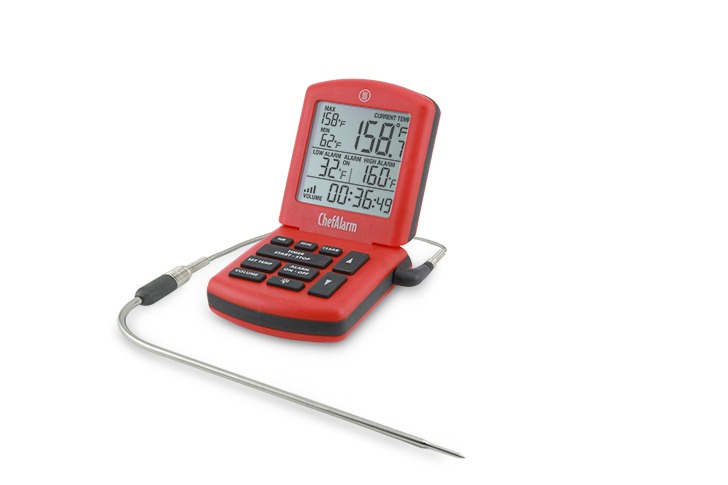

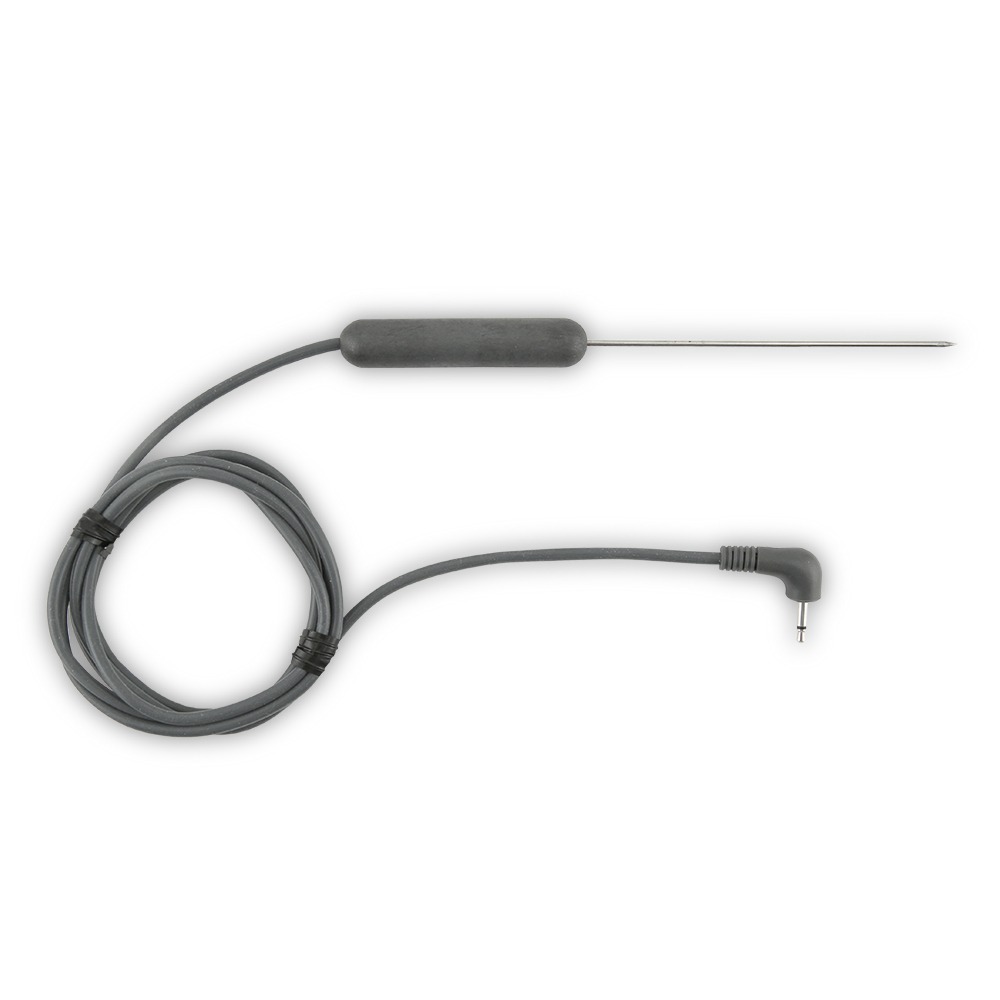
Resources:
Turkey Basics: Prophylactic Cooking, USDA
On Food and Cooking, Harold McGee
Charcoal-broil Turkey and Grilled Turkey, AmazingRibs.com, Meathead Goldwyn
The Nutrient Lab'southward Guide to Smoking a Turkey, SeriousEats.com, J. Kenji Lopez-Alt
Source: https://blog.thermoworks.com/turkey/turkey-temps/
Posted by: holtthea1980.blogspot.com



0 Response to "How Long Cooked Turkey In Fridge"
Post a Comment